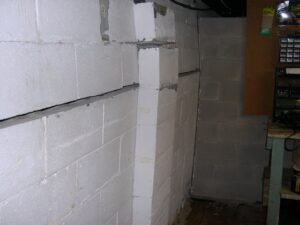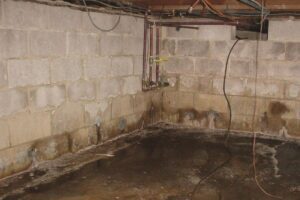The basement of a home serves as a foundation for the entire structure, providing stability and support. However, over time, basement walls may experience a common and concerning issue known as bowing. Bowed basement walls can be a significant cause for concern, as they can compromise the structural integrity of your home and pose risks to your safety. In this comprehensive guide, we’ll explore the causes of bowed basement walls, the potential risks they present, and the effective solutions available to address this issue and protect your home.
Understanding Bowed Basement Walls
Bowing in basement walls is a condition where the walls of your basement start to curve or deform inward. It often begins as a subtle, barely noticeable issue but can progress into a more serious structural problem if left unattended. There are various factors that can contribute to bowed basement walls, and it’s essential to understand these causes to address the problem effectively.
Common Causes of Bowed Basement Walls
Hydrostatic Pressure: One of the primary culprits behind bowed basement walls is hydrostatic pressure. This occurs when water accumulates in the soil surrounding your foundation, particularly during periods of heavy rainfall. The increasing water pressure pushes against the basement walls, causing them to bow inward.
Poor Drainage: Inadequate drainage systems around your home’s foundation can exacerbate the problem of hydrostatic pressure. Without proper drainage, water may pool around the foundation, putting additional pressure on the basement walls.
Expansive Soils: Some types of soil, such as clay soils, expand and contract with changes in moisture levels. When expansive soils absorb water and expand, they can exert tremendous force on the basement walls, leading to bowing.
Frost Heaving: In regions with cold winters, frost heaving can be a contributing factor. When the ground freezes, it can cause the soil to heave or push against the basement walls. This can lead to the walls bowing inward over time.
Poor Construction: Inadequate construction practices or the use of subpar materials during the initial building process can result in weaker basement walls that are more susceptible to bowing.
Risks Associated with Bowed Basement Walls
Ignoring bowed basement walls can lead to several significant risks and complications, including:
Structural Instability: The primary concern is the structural integrity of your home. Bowed walls can compromise the overall stability of the foundation, potentially leading to further structural issues, including wall collapse.
Water Infiltration: As basement walls bow inward, gaps and cracks can develop, allowing water to seep into the basement. This water infiltration can lead to moisture problems, including mold growth, and damage to personal belongings and the structure of your home.
Reduced Property Value: Bowed basement walls can significantly decrease the value of your property. Prospective buyers are often wary of homes with structural issues, making it more challenging to sell your home in the future.
Safety Hazards: The risks of bowed walls extend beyond property value. The compromised structural integrity of your home can pose immediate safety hazards to you and your family, including the potential for wall collapse.
Effective Solutions for Bowed Basement Walls
Fortunately, there are several effective solutions available to address bowed basement walls. The choice of solution depends on the severity of the problem, the underlying causes, and the specific conditions of your basement. Here are some of the most commonly used methods:
Wall Anchors
Wall anchors are a reliable and proven method for addressing bowed basement walls. They work by connecting the bowing wall to stable, load-bearing soil or bedrock outside the foundation. The process involves:
- Excavating the soil around the affected area of the foundation.
- Installing anchor rods through small holes in the bowing wall.
- Securing wall plates on the interior side of the wall.
- Connecting the anchor rods to earth anchors installed outside the foundation.
- Gradually tightening the anchors to stabilize the wall and prevent further bowing.
Wall anchors provide a long-term solution that can straighten the wall over time, ensuring the structural integrity of your basement.
Carbon Fiber Reinforcement
Carbon fiber reinforcement is a less invasive and highly effective method for addressing bowed basement walls. Carbon fiber strips are bonded to the bowed wall to stabilize and prevent further movement. The process involves:
- Preparing the wall surface by cleaning and removing any loose material.
- Applying a high-strength epoxy to the wall surface.
- Affixing carbon fiber strips to the epoxy-coated surface.
- The carbon fiber strips are anchored at the top and bottom of the wall, providing continuous support.
Carbon fiber reinforcement is an efficient solution for addressing minor to moderate bowing and can be installed quickly with minimal disruption.
Steel I-Beams
Steel I-beams are a method used for immediate stabilization of severely bowed basement walls. The process involves:
- Excavating the soil around the affected area to expose the wall.
- Installing vertical steel I-beams against the bowing wall.
- Securing the I-beams to the foundation floor and overhead structure.
- Adjusting the I-beams to apply continuous pressure against the bowing wall, providing immediate support.
Steel I-beams are effective for addressing significant bowing but may not provide a permanent solution in all cases.
Reinforced Concrete
In cases of severe bowing where the wall’s structural integrity is significantly compromised, reinforcing the wall with concrete may be necessary. This process involves:
- Excavating the soil around the affected area to expose the wall.
- Forming and pouring a new reinforced concrete wall in front of the existing bowed wall.
- Using rebar and additional reinforcement to ensure the new wall is structurally sound.
Reinforced concrete is a more invasive and costly solution but can be necessary when the structural stability of the wall is a primary concern.
Waterproofing and Drainage
To address the underlying causes of bowing basement walls, it is crucial to implement effective waterproofing and drainage solutions. These measures can help manage the hydrostatic pressure and prevent further bowing. Key components of a comprehensive waterproofing and drainage system include:
- Installation of a sump pump to remove water that accumulates in the basement.
- Properly functioning exterior drainage systems, such as French drains, to redirect water away from the foundation.
- Application of exterior waterproofing coatings to the foundation walls to prevent moisture infiltration.
Bowed basement walls are not an issue that should be taken lightly. Failing to address this problem promptly can lead to significant risks, including structural instability, water infiltration, reduced property value, and safety hazards. Fortunately, there are effective solutions available to address bowed basement walls, ranging from wall anchors and carbon fiber reinforcement to steel I-beams and reinforced concrete.
The choice of the best solution for your specific situation will depend on the severity of the bowing, the underlying causes, and the recommendations of a qualified foundation repair professional. Investing in the repair and stabilization of your bowed basement walls is not only a means of protecting your home but also an investment in the safety and well-being of your family. Don’t delay; take action to address bowed basement walls and ensure the structural integrity of your home.
Contact the Professionals at Seal-Tite Basement Waterproofing Today! 540-992-1144

Seal-tite Basement Waterproofing Co. is a full service basement environment contractor. We carry an A+ Better Business Bureau rating. We repaired over 40,000 homes and structures in Virginia, West Virginia, Tennessee, and North Carolina. We are fully insured and licensed. We have worked in all types of locations, including residential and commercial locations, government agencies, colleges, hospitals, churches, and condo associations.
Seal-tite® offers a lifetime transferable warranty. We carry a Class A Contractor’s License and we are fully insured. Our satisfied customers range from government agencies to businesses, hospitals, colleges, churches, and thousands of homeowners. Your home is probably the single largest investment you will make in your lifetime. Don’t wait, call Seal-tite® to help make your home dry, safe and livable.


 Call or email for a free estimate. For immediate help call
Call or email for a free estimate. For immediate help call  Start with trust. We’re BBB A+ Rated The Top Satisfaction Rate Awarded.
Start with trust. We’re BBB A+ Rated The Top Satisfaction Rate Awarded.